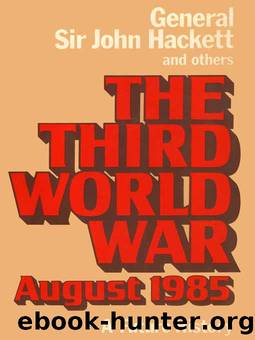The Third World War - August 1985 by General Sir John Hackett

Author:General Sir John Hackett [Hackett, General Sir John]
Language: eng
Format: epub
Tags: Alternative History
Published: 2011-12-20T18:14:07+00:00
SACLANT had been under less pressure from minute-to-minute, hour-to-hour and day-to-day events since the war broke out in Europe on 4 August than his Western Approaches colleagues. The departure from Halifax NS four days before of the group of fast military convoys which formed part of Operation CAVALRY could not possibly have gone unobserved and unreported; and the route which the convoys took could not be varied much. It was not surprising that a fierce battle was taking place, the outcome of which would be critical for events on the Central Front. Operation CAVALRY had to succeed.
SACLANT had been under no illusions about the losses which the Soviet submarines might inflict, with their horizon-range and stand-off missiles. Measures had been taken, therefore, to limit the effectiveness of the Soviet ocean surveillance satellites and air reconnaissance. Since the destruction of three of the Conakry-based reconnaissance Bears on the 4th - old models, but carrying a somewhat rudimentary and hitherto unsuspected air-to-air capability -three more Super-Bears had been removed. But indications of increased Soviet submarine movements had been reported by the four STASS ships on patrol. It looked as if the Soviet Submarine Commander had ordered his force to concentrate ahead of the CAVALRY convoys. Each of these consisted of twelve ships, stationed in three columns of four, with an escort group, including an escort carrier, disposed appropriately in the vicinity. Some distance away was a powerful ASW support group, consisting of a light aircraft carrier (with V/STOL fighter-strike-reconnaissance aircraft and anti-submarine helicopters embarked), two anti-missile cruisers and four ASW frigates. It had been intended that a second ASW support group should take station astern of the convoy formation, because submarines can attack with missiles from any direction - unlike in the days of torpedoes, when âlimiting lines of approachâ for effective attack put a premium upon the submarine pelting ahead and then âlying in waitâ for his targets. But a submarine attack upon a support group, as it formed up in Hampton Roads, had seriously damaged the carrier and sunk a frigate. The remainder of the force had been told to âget that goddamâd submarineâ and were still hopefully and energetically pursuing one or two sonar surveillance system (SOSUS) reports which could have been the culprit.
For the first two days of the transit, US and Canadian MR aircraft operating from Newfoundland would support the convoys. For the last two, RAF MR aircraft based in south-west England would take over. For the perilous two days in mid-Atlantic, the best that could be hoped for from the shore would be spasmodic cover from the already over-stretched US Navy Air Force Orion MR aircraft at Lajes in the Azores.
The Commander Strike Fleet Atlantic, entering the Iceland-Faroes gap on 10 August, was extremely thankful to have had the protection, during this transit, of fighters from Newfoundland and Iceland. These were maintained by air-to-air refuelling, and operated with the AWACS aircraft in continuous attendance. There had been a strong westerly wind, and the need to operate fixed-wing aircraft from the carriers would have slowed him down.
Download
This site does not store any files on its server. We only index and link to content provided by other sites. Please contact the content providers to delete copyright contents if any and email us, we'll remove relevant links or contents immediately.
The Radium Girls by Kate Moore(10914)
The Templars by Dan Jones(4192)
100 Deadly Skills by Clint Emerson(4084)
Rise and Kill First by Ronen Bergman(4017)
The Doomsday Machine by Daniel Ellsberg(3736)
The Rape of Nanking by Iris Chang(3522)
Killing England by Bill O'Reilly(3459)
Hitler in Los Angeles by Steven J. Ross(3443)
Stalin by Stephen Kotkin(3089)
12 Strong by Doug Stanton(3059)
Hitler's Monsters by Eric Kurlander(2736)
Darkest Hour by Anthony McCarten(2650)
Blood and Sand by Alex Von Tunzelmann(2611)
The Art of War Visualized by Jessica Hagy(2416)
Hitler's Flying Saucers: A Guide to German Flying Discs of the Second World War by Stevens Henry(2298)
The Code Book by Simon Singh(2215)
The Second World Wars by Victor Davis Hanson(2136)
Babylon's Ark by Lawrence Anthony(2073)
Tobruk by Peter Fitzsimons(2064)
